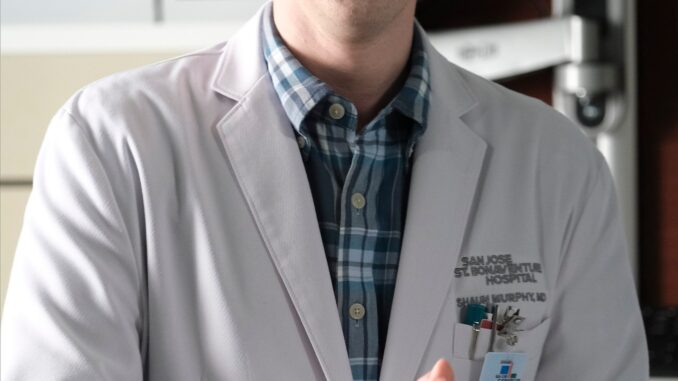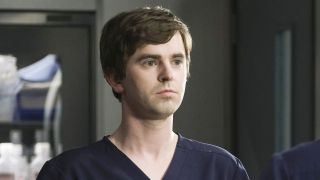
Ever since Grey’s Anatomy went haywire and hits like House, Nurse Jackie, and ER completed formidable seasons-long runs, folks have been clamoring for the next great medical procedural. This fall, it seems they got their wish with ABC’s new drama The Good Doctor, created by House’s David Shore and based on a Korean series of the same name. Is The Good Doctor “great”? Well, not exactly, but it does enough to fill the void in a genre that’s always been less about medicine than the often galactic, always dramatic goings-on at our favorite fictitious hospitals.
Last week, after just three episodes, The Good Doctor became the most-watched show on US television, surpassing The Big Bang Theory, which has held that title for quite some time despite running on pseudo-comic fumes. Yes – “most-watched” is a superlative that’s both widely appropriated and, in the age of multi-platform viewing increasingly irrelevant – but 18.2 million viewers, which The Good Doctor reeled in last week, is nothing to scoff at, especially as it trounces flashier fall debuts like The Orville, The Gifted and Seal Team and runs neck-and-neck with CBS’s Big Bang Theory spinoff Young Sheldon. It also received a full-season order at ABC after only two episodes and has found a quietly passionate fanbase on Facebook (the show’s official page already boasts over 650,000 likes), where fans praise its depiction of autism and attest that the soapy medical plotlines have reduced them to tears. There’s even talk of an Emmy nod for its star Freddie Highmore, of Bates Motel fame.

The premise is simple: Shaun Murphy, played by Highmore, is an autistic surgeon with savant syndrome. His stream of consciousness speaks the language of anatomy, and when the show’s particularly keen on calling attention to his genius, organs and veins and glands float above his head like illustrations ripped from a med-school textbook. “He’s not Rain Man,” says his main advocate at the prestigious St Bonaventure hospital in an attempt to convince the board that Murphy is hirable and high-functioning. To those in the autism community, the show has deftly done just that. “The Good Doctor does a fine job of navigating this razor’s edge,” wrote Kerry Magro on the website Autism Speaks, noting that it shows “several characteristics that can accompany an autism diagnosis such as social awkwardness, lack of eye contact, playing with his hands during stressful situations”. He adds: “Freddie’s take will resonate with many in the community.”
As for its entertainment value, The Good Doctor proceeds the way most medical dramas do: each day brings a new patient in need of life-threatening surgery; the doctors fight for stature and opportunity while romancing one another in the process; we discover that Shaun’s childhood was marred by the gruesome deaths of both his little brother and pet bunny, and he’s disciplined for behaving poorly or erratically in front of patients before saving the day with surgical heroics. It’s schmaltzy and sentimental, and it’s probably no coincidence that as hitmaker Shonda Rhimes (of Scandal, Grey’s and How to Get Away with Murder fame) prepares to leave ABC for Netflix, the network has pushed a new drama to the forefront of its programming. And like Grey’s Anatomy, The Good Doctor has accrued a wide fanbase in just a few episodes by weaving the day-to-day tasks of surgeons into the larger framework of its protagonist’s story. In its first season, Grey’s brought in roughly 18.5 million viewers per episode, and so far The Good Doctor, with more than half of its audience watching the show live and the rest on DVR, is outperforming both that show at the same stage and others in the same lineage, like House and Private Practice.
How The Good Doctor became the year’s biggest new TV hit
Ever since Grey’s Anatomy went haywire and hits like House, Nurse Jackie, and ER completed formidable seasons-long runs, folks have been clamoring for the next great medical procedural. This fall, it seems they got their wish with ABC’s new drama The Good Doctor, created by House’s David Shore and based on a Korean series of the same name. Is The Good Doctor “great”? Well, not exactly, but it does enough to fill the void in a genre that’s always been less about medicine than the often galactic, always dramatic goings-on at our favorite fictitious hospitals.

Last week, after just three episodes, The Good Doctor became the most-watched show on US television, surpassing The Big Bang Theory, which has held that title for quite some time despite running on pseudo-comic fumes. Yes – “most-watched” is a superlative that’s both widely appropriated and, in the age of multi-platform viewing increasingly irrelevant – but 18.2 million viewers, which The Good Doctor reeled in last week, is nothing to scoff at, especially as it trounces flashier fall debuts like The Orville, The Gifted and Seal Team and runs neck-and-neck with CBS’s Big Bang Theory spinoff Young Sheldon. It also received a full-season order at ABC after only two episodes and has found a quietly passionate fanbase on Facebook (the show’s official page already boasts over 650,000 likes), where fans praise its depiction of autism and attest that the soapy medical plotlines have reduced them to tears. There’s even talk of an Emmy nod for its star Freddie Highmore, of Bates Motel fame.

The premise is simple: Shaun Murphy, played by Highmore, is an autistic surgeon with savant syndrome. His stream of consciousness speaks the language of anatomy, and when the show’s particularly keen on calling attention to his genius, organs and veins and glands float above his head like illustrations ripped from a med-school textbook. “He’s not Rain Man,” says his main advocate at the prestigious St Bonaventure hospital in an attempt to convince the board that Murphy is hirable and high-functioning. To those in the autism community, the show has deftly done just that. “The Good Doctor does a fine job of navigating this razor’s edge,” wrote Kerry Magro on the website Autism Speaks, noting that it shows “several characteristics that can accompany an autism diagnosis such as social awkwardness, lack of eye contact, playing with his hands during stressful situations”. He adds: “Freddie’s take will resonate with many in the community.”
As for its entertainment value, The Good Doctor proceeds the way most medical dramas do: each day brings a new patient in need of life-threatening surgery; the doctors fight for stature and opportunity while romancing one another in the process; we discover that Shaun’s childhood was marred by the gruesome deaths of both his little brother and pet bunny, and he’s disciplined for behaving poorly or erratically in front of patients before saving the day with surgical heroics. It’s schmaltzy and sentimental, and it’s probably no coincidence that as hitmaker Shonda Rhimes (of Scandal, Grey’s and How to Get Away with Murder fame) prepares to leave ABC for Netflix, the network has pushed a new drama to the forefront of its programming. And like Grey’s Anatomy, The Good Doctor has accrued a wide fanbase in just a few episodes by weaving the day-to-day tasks of surgeons into the larger framework of its protagonist’s story. In its first season, Grey’s brought in roughly 18.5 million viewers per episode, and so far The Good Doctor, with more than half of its audience watching the show live and the rest on DVR, is outperforming both that show at the same stage and others in the same lineage, like House and Private Practice.
But before The Good Doctor and last year’s network breakout This is Us, a non-linear tearjerker about a family with three children who share a birthday, it had been a while since a debut series on either CBS, ABC, NBC or Fox became a ratings powerhouse. Network television was mostly underwhelming or, like The Big Bang Theory, stagnant and formulaic, and so viewers flocked instead to cable (HBO, AMC, FX) or streaming services (Netflix, Amazon, Hulu).
In that sense, network dramas are the new underdogs, at least in relation to the Game of Thrones and Walking Deads of the world. But perhaps they won’t be any longer, since both The Good Doctor and This is Us provide the guilty pleasures many people look for in their TV diets: earnest storytelling, very attractive actors doing very noble things, and characters who tug at our heartstrings. Both shows, too, have diverse casts and optimistic outlooks, debuting as the collective national mood called for encouraging, beat-the-odds entertainment in the vein of La La Land, Hidden Figures and Wonder Woman.
